





PHOTO GALLERY

Photos by Len Blumin
1. "Mirror, Mirror on the Wall..."
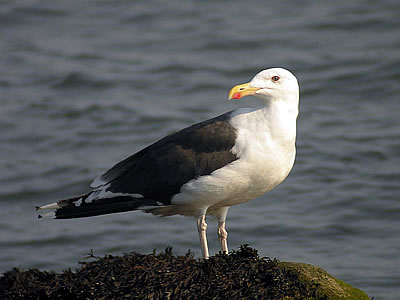
"...who's the biggest gull of all?"
The Great Black-backed Gull (Larus marinus) is the largest gull in the world, weighing in at 3.5 pounds (1.65 kg) and sporting a 65" wingspan. A bulky-looking character, with a huge bill and a no-nonsense glare from the pale iris, and here showing the red orbital ring seen in summer (breeding). We watched these gulls every day in East Haven, CT, where they were at the top of the shoreline food chain. They have a nasty reputation for eating the eggs and young of other seabirds. This adult is at least four years old. Others we saw were mostly juveniles molting into first-winter plumage. Sorry, but he didn't open to show his red gape. Note the light pink legs and rich slate-black color of the back.
2. Gaping Gull
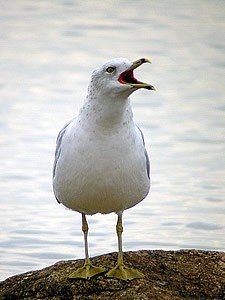
The Ring-billed Gull, Larus delawarensis, is a smaller gull, and rather "common". Not only is it widely distributed, but its appearance at dumps and fast-food franchises does not do much to endear it to bird-lovers. But even this humdrum species can charm and entertain us, given a chance. We watched a flock of them catching insects on the wing in East Haven, CT, and this one displayed his fire-red gape while vocalizing to an intruder to his patch of shoreline. Many gulls look alike, and the color of the gape can occasionally be a helpful field-mark. The pale iris, black ring on the bill and yellow feet are also characteristic.
3. Ruff (Philomachus pugnax)
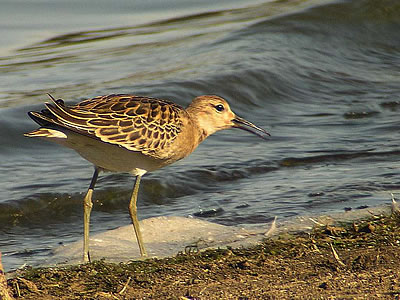
The Ruff is a rather distinctive shorebird that breeds in North Eurasia and winters to the south, mostly in Africa. Lucky for us a few individuals wander elsewhere in the world, and one such vagrant appeared about a week ago at Shollenberger Marsh, in Petaluma, California! Patti and I went there Sept 21 with Don Reinberg, and we were thrilled to find our first ever Ruff, feeding along a long thin island parallel to the (south?) berm that starts at PRBO and heads southwest toward the Petaluma River. The juveniles have beautiful scaling of the coverts, with buffy edges. Photo not the sharpest, as camera preferred to focus on the water beyond!
Philomachus = "loving to fight", or "warlike". The incredibly and varied feathered breeding males apparently engage in spirited jousting and displays at their leks.
pugnax = "combative, pugnacious..."
Ruff = contracted form of "ruffle", the fluffing up of neck feathers seen in the excited males. Who would'a guessed...
4. Juvenile Ruff
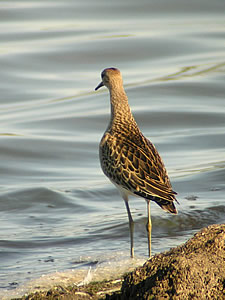
The Ruff is sexually dimorphic, with the males developing a striking wreath of feathers encircling the neck and head during breeding season, while the female (previously called "Reeve") changes little from basic plumage. The males also exhibit sexual polymorphism, with remarkable variation in the colors of the feathers. The Ruff is said to have a long neck and small head, which we were able to appreciate when it wasn't probing the mud for treats. Yes, it really is the same bird!
5. Young Great Black-backed Gull ( Larus marinua)
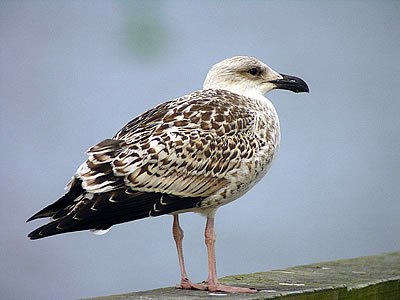
Adult gulls are hard enough, but the younger gulls are a real challenge. Some gulls take a full four years to reach adult plumage, and molt about twice a year along the way. The juvenile gulls fledge around June/July, and by September they have already begun to molt into what is called "First Winter" plumage. In this young Great Black-backed Gull, some of the darker juvenile head feathers have been shed, but the striking "checkered" pattern on the scapulars and coverts is retained. Similar to the young Herring Gull (below), which has less obvious checkering because of a more narrow white edge to the feathers. Note the impressive black bill, relatively white head, and bubble-gum pink legs. Taken in New Haven harbor, Sept 10, 2006, digi-scoped.
The Greater Black-backed Gull is widely distributed in the North Atlantic, from the Florida Coast northward to Canada, then across to Greenland, Iceland, Scandanavia and down to Spain. PJ Grant's book (Gulls - a Guide to Identification) contains a nice table on features that distinguish the GBBG from the Lesser Black-backed and Herring Gulls.
6. Young Herring Gull (Larus argentatus)
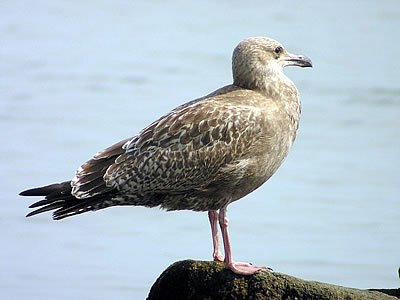
Common and widely distributed in the Northern Hemisphere, the Herring Gull is variable in appearance, and the species has been subdivided into numerous subspecies. Sibley states: "...Variation in its size, structure, and plumage can create confusion with almost every other large gull species". Not to mention the fact that the Herring Gull can hybridize with a number of them to boot (one species at a time, anyway). That said, I'm venturing to guess that this bird is a first winter Herring Gull, with nicely scaled back, dark eye, pink legs, and a dark bill that is becoming light at the base. Guess it could be a second winter bird, but they are said to have a lighter iris and often a lighter head. Taken Sept 8th, 2006, New Haven, CT. Compare to Black-backed Gull (above).
Larus = from the Greek laros, for a "ravenous seabird".
argentatus = not from Argentina (you knew that), but rather from the Latin word for silver, the color of the back and wings in the adult.
Herring = for a favorite fish that it scavenges. Eats just about any food that it can find or steal. Has thrived by hanging out at garbage dumps.
Gull = from the Celtic "gullan" for this type of bird.
(word derivations from Holloway's "Dictionary of Birds")
Gull Taxonomy
A while ago I wrote about how almost all of the 50-odd species of gulls are in the genus Larus. Well, the avian genetic sleuths have been refining their thinking, and according to the ABA have proposed a classification scheme that includes several new genera, based on logical groupings (from the work of Pons, Hassanin and Crochet). I hope you can use the link below to review the file. It contains the citation of the work by Pons et. al.
http://americanbirding.org/pubs/birding/archives/vol38no5p23w1.pdf
In case you are not able to see it, the scheme divides the gull genera (and species) as follows:
Larus - "White-headed" Group - 19 species, including many west coast US gulls.
Larus - "Band-tailed" Group - 4 species, 2 with great names (Olrog's and Belcher's Gulls).
Chroicocephalus - "Masked" Group - 11 species, including Bonaparte's Gull.
Ichthyaetus - "Black-headed" Group - 6 species, none regular in US.
Leucophaeus - "Hooded" Group - 5 species, including Laughing Gull.
Hydrocoloeus - 2 species (Little Gull and Ross's Gull)
Sandersilarus - 1 species (Saunders's Gull)
Xema - 1 species (Sabine's Gull)
Pagohila - 1 species (Ivory Gull)
Greagus - 1 species (Swallow-tailed Gull)
Rissa - 2 species, the Kittiwakes.
So, if I've gotten it right, we have 11 groups, 10 genera, 54 species. Whew!
7. The Sentinel
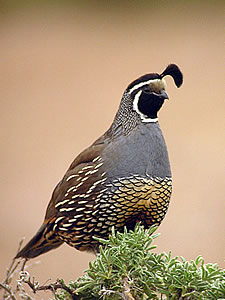
The California Quail, Callipepla californica, is the official state bird. Here a male stands watch atop a Bush Lupine at the Abbott's Lagoon trailhead, Point Reyes National Seashore. The covy rustled about quietly below. He sings "o Hi o" to re-assemble the group after they scatter from the bumbling intrusions of bipeds.
The soft background is from out of focus hay in the field beyond. The scaling on the breast and neck, dark crown and pale forehead all serve to distinguish him from Gambel's Quail, not found in Coastal California.
TOWHEE.NET: Harry Fuller, 820 NW 19th Street, McMinnville, OR 97128
website@towhee.net